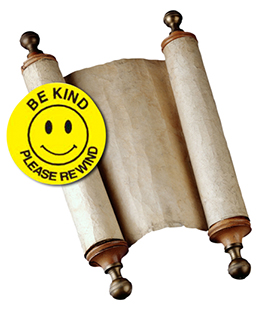REWIND: A thought for Simchat Torah
Permanent link All Posts
Few things "scroll" anymore, but many things used to.
Take audio recordings. The ones that came with sound already on them were almost always discs: 78s, 45s, LPs, CDs, and the short-lived mini-discs. But if you wanted to record your own sound you had to use a reel-to-reel machine. Recording studios use master tapes. Later, these were reduced in size to 8-tracks, then casettes, which contained minitaure tape reels. Mini-cassettes were used for what voice recorders do now, and for answering machines.
Now, sound recordings— made in studios or downloaded— are digital files with no moving parts involved.
Movies were once on huge reels. These were delivered to theaters, often marked in code so they would not be stolen. Now, even the most picky directors are willing to try digital recordings, which can be e-mailed directly.
The same is true for making home movies. As the movie Super 8 remembers, home cameras once used film that unravelled, captured a split-second of motion, then re-revalled on another spool. To watch them, we had to rewind them and feed them into a projector¸with its own reels. Now, we press a button on our phones.
Then there is watching movies at home. This recently involved a videocasette. Like its audio cousin, it is a rectangle containing two reels. One winds a tape so that the machine can display the image on the TV screen while the other unwinds it. When we were done, we were cajoled by a sticker on the box, we were supposed to "be kind" and "rewind" the tape back to the start for the next viewer.
Computers the size of refrigerators used to fill rooms. Many of these machines had pairs of reels on their faces with a magnetic tape winding between them, recording and reporting data. Today, a drive the size of a thumb contains more memory than dozens of such reels. And we "scroll" on a computer screen only virtually.
In some movies, you can see researchers looking at screens onto which old newspaper pages are projected. Those pages were photographed, and the photos condensed onto microfilm in an early version of scanning. Now, many of these archives have been scanned digitally.
Wherever we turn, things have stopped turning. We still unwind things from spools— everything from thread and tape to paper towels and foil. But we don't "rewind" that much anymore.
So why has the simple parchment-on-poles technology of the Torah scroll outlasted all of these other, more high-tech "scrolls"? Why are we still rolling back this huge scroll so many centuries past the printing press? And why would we not give it up for all the e-readers in the world?
Just something to think about as we finished reading the Torah this week and "rewind" the scroll back to the beginning.



.jpg)



